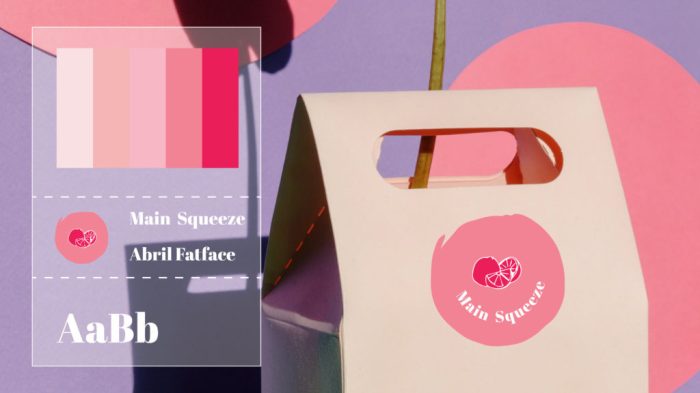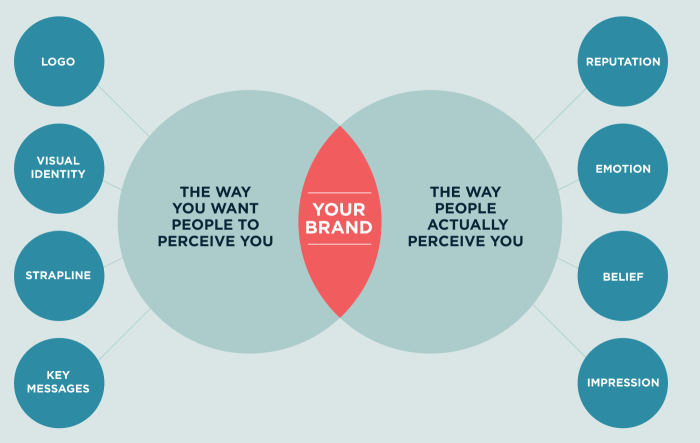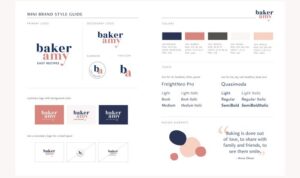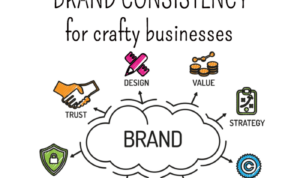Kicking off with Developing a Visual Brand Identity, this topic dives into the art of creating a powerful brand image that resonates with customers and stands out in a crowded market. From choosing the right colors to designing a memorable logo, every detail plays a crucial role in shaping a brand’s identity. Get ready to explore the world of visual branding and discover how to make your brand visually appealing and unforgettable.
Understanding Visual Brand Identity
Visual brand identity encompasses the visual elements that represent a brand and help differentiate it from competitors. These elements include logos, color palettes, typography, imagery, and overall design style.
Examples of Elements in Visual Brand Identity
- Logo: A unique symbol or design that represents the brand.
- Color Palette: Specific colors chosen to represent the brand and evoke certain emotions.
- Typography: Fonts and typography styles used consistently across all brand materials.
- Imagery: The style of images and graphics used to visually communicate the brand’s message.
- Design Style: The overall look and feel of the brand’s visual assets, including layouts and graphic elements.
Importance of a Strong Visual Brand Identity
A strong visual brand identity is essential for a business as it helps create brand recognition, build trust with customers, and differentiate the brand in a crowded market. Consistent visual elements across all brand touchpoints help establish a cohesive brand image and make the brand more memorable to consumers.
Creating a Visual Brand Identity: Developing A Visual Brand Identity
Developing a visual brand identity is crucial for establishing a strong and recognizable presence in the market. It involves a strategic process of visually representing your brand to convey its values, personality, and message effectively.
Choosing Colors, Fonts, and Imagery
When selecting colors, fonts, and imagery for your brand, it is essential to consider how they will resonate with your target audience and communicate the desired brand image. Colors can evoke specific emotions and associations, so choose ones that align with your brand’s values. Fonts should be legible and reflect the tone of your brand, whether it’s modern, casual, or professional. Imagery should be cohesive and relevant to your brand, enhancing its overall visual identity.
- Colors: Use a color palette that reflects your brand’s personality and resonates with your target audience. Consider the psychology of colors and how they can influence perception.
- Fonts: Select fonts that are easy to read and align with the tone of your brand. Whether you choose a serif, sans-serif, or script font, ensure consistency in all brand materials.
- Imagery: Use visuals that are consistent with your brand’s messaging and values. Whether it’s photography, illustrations, or graphics, ensure they convey the right message to your audience.
Creating a Logo
A logo is a visual representation of your brand and plays a significant role in brand recognition. When designing a logo, it’s essential to keep it simple, memorable, and versatile. Your logo should reflect your brand’s identity and be easily recognizable across different platforms and mediums.
- Simplicity: A simple logo is more likely to be remembered and easily identifiable. Avoid clutter and unnecessary elements that can dilute your brand message.
- Memorability: Create a logo that stands out and leaves a lasting impression on your audience. Unique and distinctive logos are more likely to be remembered.
- Versatility: Ensure your logo looks good in different sizes and formats, whether it’s on a website, social media, or printed materials. A versatile logo will maintain its impact across various platforms.
Consistency in Visual Branding

Consistency in visual branding is crucial for creating a strong brand identity that is easily recognizable and memorable. It helps to establish trust and credibility with your audience, as they know what to expect from your brand. Consistency also contributes to brand recognition, making it easier for customers to identify your products or services in a crowded marketplace.
Tips for Maintaining a Consistent Visual Brand
- Define brand guidelines: Establish a set of rules for logo usage, color palette, typography, and imagery to ensure consistency across all platforms.
- Use templates: Create templates for marketing materials, social media posts, and other visual content to maintain a cohesive look and feel.
- Train your team: Educate your team members on the importance of visual consistency and provide them with the tools and resources they need to uphold brand guidelines.
- Regularly review and update: Regularly review your visual assets to ensure they align with your brand guidelines and make updates as needed to stay current.
The Impact of Consistency on Brand Recognition and Customer Loyalty
Consistency in visual branding plays a significant role in brand recognition, as customers are more likely to remember and recall brands that maintain a consistent look and feel. This leads to increased brand awareness and can help you stand out in a competitive market. Additionally, consistency builds trust with customers, as they know what to expect from your brand and are more likely to develop a sense of loyalty towards it.
Evolving a Visual Brand Identity

Visual brand identities are not static and unchanging; they evolve over time to stay relevant and appealing to target audiences. As market trends shift and consumer preferences evolve, brands must adapt and update their visual identities to remain competitive and resonate with their customers.
Role of Market Trends and Consumer Preferences
Market trends and consumer preferences play a crucial role in shaping a brand’s identity. Brands need to stay attuned to changes in the market landscape, such as emerging design styles, popular color palettes, and innovative branding techniques. By understanding what appeals to their target audience, brands can make informed decisions about how to evolve their visual identity to stay current and engaging.
- Monitoring social media trends and influencers can provide valuable insights into what visuals are resonating with consumers.
- Conducting market research and surveys can help brands understand shifting preferences and identify areas for improvement in their visual branding.
- Collaborating with design experts and creative agencies can bring fresh perspectives and innovative ideas to the brand identity evolution process.
Successful Brand Identity Evolution Strategies, Developing a Visual Brand Identity
Successful brands have implemented various strategies to evolve their visual brand identities effectively. Here are some examples:
- Apple: Apple’s minimalist and sleek brand identity has evolved over the years, staying true to its core values of simplicity and innovation while adapting to modern design trends.
- Coca-Cola: Coca-Cola has successfully evolved its iconic red and white branding to stay relevant across different markets and demographics, while maintaining its timeless appeal.
- Nike: Nike’s visual brand identity has evolved to reflect changing attitudes towards health and wellness, embracing diversity and inclusivity in its marketing campaigns and design choices.












